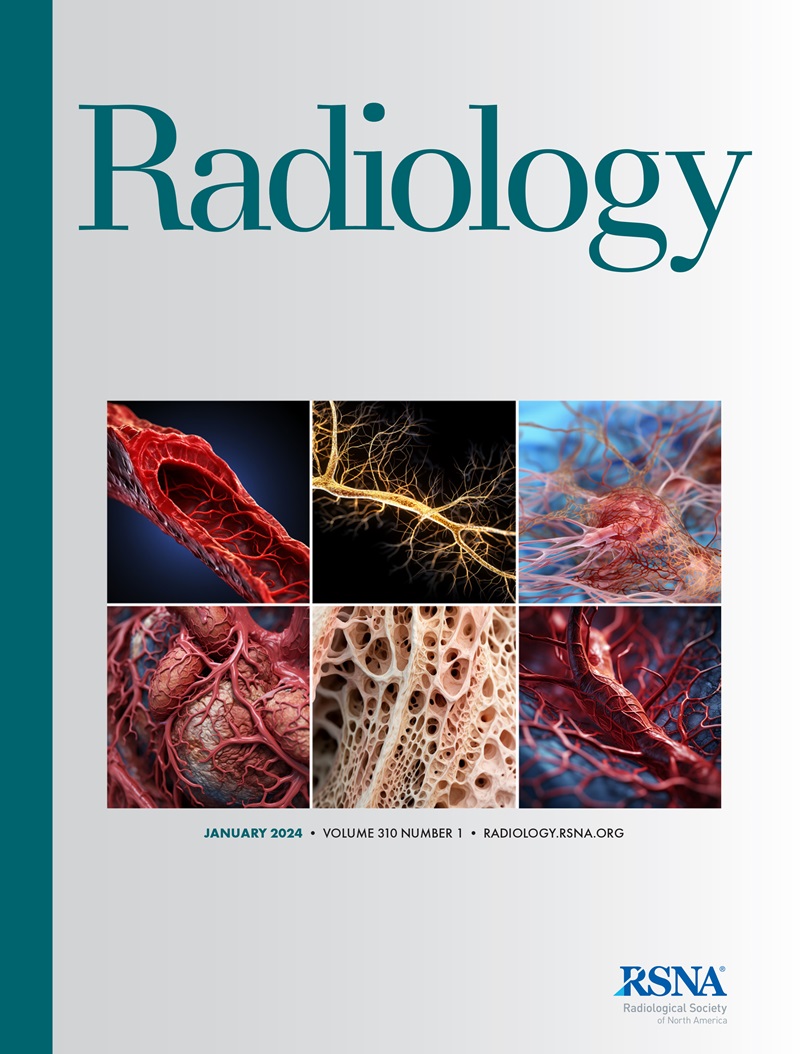Risk Stratification of Sudden Cardiac Death in Nonischemic Dilated Cardiomyopathy: Arrhythmogenic Substrate Assessment in Cardiac MRI.
IF 15.2
1区 医学
Q1 RADIOLOGY, NUCLEAR MEDICINE & MEDICAL IMAGING
引用次数: 0
Abstract
Background MRI-derived arrhythmogenic substrate, including late gadolinium enhancement (LGE) and extracellular volume fraction (ECV), is indicative of sudden cardiac death (SCD) risk in nonischemic dilated cardiomyopathy (DCM). The relative prognostic value of LGE and ECV remains unclear. Purpose To evaluate the performance of LGE and T1 mapping in predicting SCD in patients with DCM and to explore clinical implementation. Materials and Methods This study enrolled 1105 patients with DCM who underwent cardiac MRI at four centers. The data were analyzed in a development cohort (n = 837, single center) and an external validation cohort (n = 268, multicenter). The primary end point comprised SCD, appropriate implantable cardioverter-defibrillator shock, and resuscitated cardiac arrest. The secondary end point comprised heart failure-related death, heart transplant, and left ventricle (LV) assist device implantation. Risk algorithms and a clinical workflow for SCD risk assessment were developed based on validated MRI predictors. Results In the development cohort, 78 patients reached the primary end point and 120 reached the secondary end point over a median follow-up of 58.3 months. In the adjusted analysis, LGE of at least 7.2% of the LV mass (hazard ratio [HR], 4.75 [95% CI: 2.91, 7.74]; P < .001), an ECV of at least 31.8% (HR, 2.91 [95% CI: 1.63, 5.22]; P = .001), and a native T1 z score of at least 2.1 (HR, 1.69 [95% CI: 1.04, 2.74]; P = .04) were associated with SCD-related events. Patients with an ECV of at least 31.8% and no LGE were at a higher risk of SCD events compared with those with an ECV less than 31.8% and presence of LGE of less than 7.2% or midwall and/or focal LGE. Patients with an LV ejection fraction greater than 35%, LGE less than 7.2%, and an ECV less than 31.8% exhibited a low risk of SCD, with an annual event rate of 0.2%. Patients with LGE of at least 7.2% exhibited a high risk of SCD-related events (annual event rate, 4.65%) irrespective of ECV and native T1 value and LGE distribution and/or pattern. Conclusion In nonischemic DCM, LGE of at least 7.2% was strongly predictive of SCD risk irrespective of distribution and pattern. ECV significantly enhanced risk stratification, particularly in patients with negative or focal and/or midwall LGE. © RSNA, 2025 Supplemental material is available for this article. See also the editorial by Sakuma in this issue.非缺血性扩张型心肌病心源性猝死的风险分层:心脏MRI致心律失常底物评估。
mri来源的致心律失常底物,包括晚期钆增强(LGE)和细胞外体积分数(ECV),表明非缺血性扩张型心肌病(DCM)的心源性猝死(SCD)风险。LGE和ECV的相对预后价值尚不清楚。目的评价LGE和T1定位对DCM患者SCD的预测价值,探讨临床应用价值。材料和方法本研究纳入了1105例DCM患者,他们在4个中心接受了心脏MRI检查。数据在一个发展队列(n = 837,单中心)和一个外部验证队列(n = 268,多中心)中进行分析。主要终点包括SCD、适当的植入式心律转复除颤器休克和复苏的心脏骤停。次要终点包括心力衰竭相关死亡、心脏移植和左心室辅助装置植入。基于验证的MRI预测因子,开发了SCD风险评估的风险算法和临床工作流程。在发展队列中,78名患者在58.3个月的中位随访期间达到了主要终点,120名患者达到了次要终点。在校正分析中,LGE至少为左室质量的7.2%(风险比[HR], 4.75 [95% CI: 2.91, 7.74]; P < 0.001), ECV至少为31.8%(风险比,2.91 [95% CI: 1.63, 5.22]; P = 0.001),原生T1 z评分至少为2.1(风险比,1.69 [95% CI: 1.04, 2.74]; P = 0.04)与scd相关事件相关。与ECV小于31.8%且LGE小于7.2%或中壁和/或局灶性LGE的患者相比,ECV≥31.8%且无LGE的患者发生SCD事件的风险更高。左室射血分数大于35%,LGE小于7.2%,ECV小于31.8%的患者发生SCD的风险较低,年事件发生率为0.2%。LGE≥7.2%的患者发生scd相关事件的风险较高(年事件发生率为4.65%),与ECV和原生T1值以及LGE分布和/或模式无关。结论在非缺血性DCM中,无论分布和模式如何,至少7.2%的LGE都是SCD风险的有力预测指标。ECV显著增强了风险分层,特别是在阴性或局灶性和/或中壁LGE患者中。©RSNA, 2025本文可获得补充材料。请参阅佐久间在本期的社论。
本文章由计算机程序翻译,如有差异,请以英文原文为准。
求助全文
约1分钟内获得全文
求助全文
来源期刊

Radiology
医学-核医学
CiteScore
35.20
自引率
3.00%
发文量
596
审稿时长
3.6 months
期刊介绍:
Published regularly since 1923 by the Radiological Society of North America (RSNA), Radiology has long been recognized as the authoritative reference for the most current, clinically relevant and highest quality research in the field of radiology. Each month the journal publishes approximately 240 pages of peer-reviewed original research, authoritative reviews, well-balanced commentary on significant articles, and expert opinion on new techniques and technologies.
Radiology publishes cutting edge and impactful imaging research articles in radiology and medical imaging in order to help improve human health.
 求助内容:
求助内容: 应助结果提醒方式:
应助结果提醒方式:


